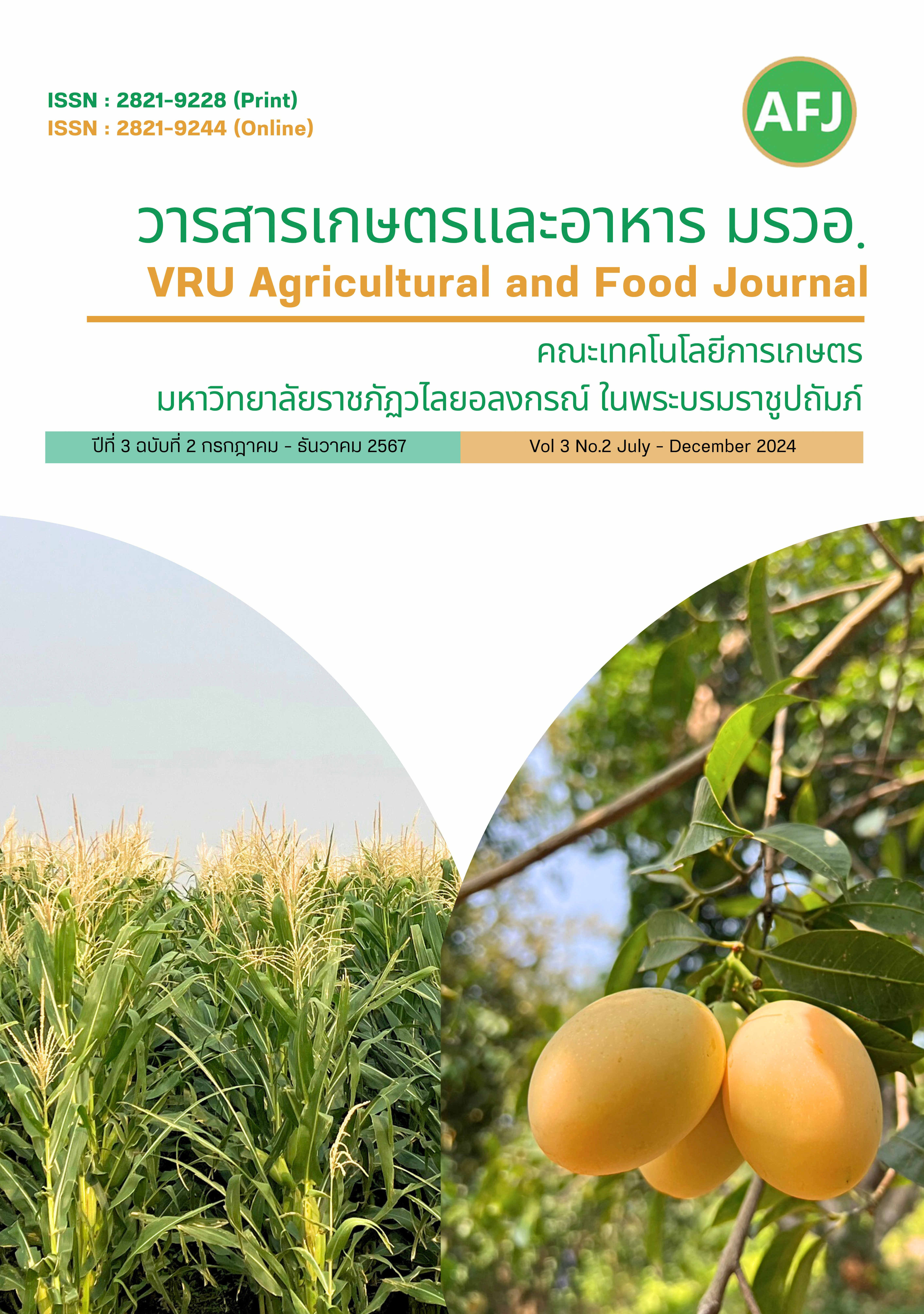Evaluation of Varieties and Suitable Organic Fertilizer Rates for Organic Cassava Production
Main Article Content
Abstract
Growing cassava in an organic system to achieve suitable yields and economic efficiency requires knowledge about the appropriate varieties and the proper rates of organic fertilizers. This research aims to evaluate cassava varieties and study the suitable rates of organic fertilizers for growing cassava in an organic system. The research was conducted at the Organic Crop Research Center, Ubon Ratchathani Agricultural Research Center, Ubon Ratchathani Province, through three experiments: 1) The identification of suitable cassava varieties for cultivation in organic systems, the experimental design was a randomized complete block (RCB) with 7 treatments and 3 replications. The varieties were Rayong 7, Rayong 72, Rayong 11, Rayong 86-13, Rayong 15, Huay Bong 60, and Kasetsart 50. 2) The study of the optional rates of aerated compost manure and 3) the optimal rates of rick husks chicken manure for cassava cultivation in organic systems. These studies employed an RCB experimental design with 7 treatments and 3 replications. The treatment included a control (no organic fertilizer) and various organic fertilizer application rates as 6, 9, 12, 15, 18, and 21 times the nitrogen analysis value of the organic fertilizer. The results indicated that the cassava variety Rayong 11 was the most suitable for organic cultivation. The optimal rates of aerated compost and chicken manure with rice husk for high starch yield and high economic returns were found to be: aerated compost at a rate of 21 times the N value (2,100 kg/rai) and chicken manure with rice husk at rates of 12 times (1,200 kg/rai) the N value.
Article Details

This work is licensed under a Creative Commons Attribution-NonCommercial-NoDerivatives 4.0 International License.
This article is published under a Creative Commons Attribution-NonCommercial-NoDerivatives 4.0 International License (CC BY-NC-ND 4.0), which allows others to share the article with proper attribution to the authors and prohibits commercial use or modification. For any other reuse or republication, permission from the journal and the authors is required.References
Agbede, T.M., S.O. Ojeniyi and A.J. Adeye mo. 2008. Effect of poultry manure on soil physical and chemical properties, growth and grain yield of sorghum in southwest, Nigeria. Am. -Eurasian J. Sustain. Agric. 2: 72-77.
Agbim, N.N. 1985. Potential of cassava peels as soil amendment II. J. Environ. Qual. 14: 411-415.
Amanullah, M.M., S. Sekar and P.P. Muthukrish nan. 2010. Prospects and potential of poultry manure. Asian J. Plant Sci. 1-11.
Amonpon, W., S. Luanmanee, K. Paisancharoen, C. Pakddeethai, B. Srimungkun, P. Kalayasilapin, S. Tancharoen, S. Klongchang, A. Tiensiriroek, P. Muangsong, U. Wongchanapai, S. Thippayarugs, R. Boontung, P. Wongchanapai, A. Tippayawat, D. Kongthien, S. Phengkham, S. Sukto, J. Jarunate, T. Chuekittisak, V. Amonpon, K. Chusoon, M. Klomkaeww, M. Putkhao, C. Phruetthithep, N. Wannasai, P. Meunchang, N. Taweekul, S. Lapbanjop, R. Pratcharoenwanich, S. Bumrung, A. Summart, P. Jinjakarn, W. Chansrakoo, W. Nobuntou, W. Wannjak, R. Pansaita, A. Tongpoo, S. Auttajarusit, P. Namwong, K. Champathong, W. Thongmee and S. Boonpradup. 2015. Research and development on cassava cultural practice management. Department of agriculture. Bangkok. (in Thai)
Biratu, G. K., E. Elias, P. Ntawuruhunga and N. Nhamo. 2018. Effect of chicken manure application on cassava biomass and root yields in two agro-ecologies of Zambia. Agriculture. 8(45): 1-15. Doi:10.3390/agriculture8040045.
Department of Agriculture. 2023. System for inspecting and certifying organic plant production sources. Available Source: http://organic.doa.go.th/homepage, August 7, 2024. (in Thai)
Department of Land Development. 2023. Average amount of nutrients contained in animal manure. Available Source: https://osd101.ldd.go.th/q/manual/table_compost.pdf, August 7, 2024. (in Thai)
Klongtham, R., S. Anusontpornperm, S. Thanachit and I. Kheoruenromne. 2020. Cumulative effect of chicken manure, cassava starch manufacturing wastes and chemical fertilizer on cassava grown in Yasothon soil series. Khon Kaen Agriculture Journal. 48(6): 1292-1303. doi:10.14456/kaj.2020.114. (in Thai)
Komariah, K., M. Ito, J. Senge, T. Adomako and Afandi. 2008. Amendment of soil physical and biological properties using rice husk and tapioca wastes. J. Japanese Soc. Soil Phys. 108: 81-90.
Nilawong, V. 2018. Study on plant available nitrogen release in the soils applying different organic fertilizers. King Mongkut’s Agr. J. 36: 178-188. (in Thai)
Office of Agricultural Economics. 2023. Agricultural economic information by product. Available Source: https://www.oae.go.th/assets/portals/1/files/jounal/2565/commodity2564.pdf, July 30, 2024. (in Thai)
Okonkwo, C., I. Onyibe and C.N. Mbah. 2011. Influence of different forms of cassava peel on physicochemical properties of an Ultisol and yield of Maize (Zea mays L.) in Abakaliki south eastern Nigeria. J. Agric. Bio. Sci. 2: 78-83.
Shafeek, M.R., M. Omar. Nadia, R.A. Mahmad and M.M.H. Abd El-Baky. 2012. Effect of Bio- organic fertilization on growth and yield of cassava plants in newly cultivated land. Middle East J. Agric. Res. 1(1): 40-46.
Sok, S., I. Malik, J. Newby and K. Fahrney. 2018. Effect of fertilizer on growth and yield of cassava (Manihot esculenta Crantz). Available Source: https://research.aciar.gov.au/cassavavaluechains/wp-ontent/uploads/2018/01/Effect-of-Fertilizer-on-Growth-and-Yield-of-Cassava_SRIRJN.pdf, August 8, 2024.
Srimungkun, B., O. Wannawong, W. Prasomthong, and S. Chompoonukulrat. 2009. Annual reported 2010 of Ubon ratchathani field crop research center, Effects of nutrients on the amount of antioxidants in sesame (report P. 251-257). Ubon ratchathani, Thailand: Department of agriculture. (in Thai)
Vichukit, V., E. Sarobol, W. Lertmongkol, J. Jiamjumnanja, P. Changlek, P. Serivichayaswadi, P. Sarangrum, B. Phromsri, W. Kampanich, W. Sirichuaychoo and T. Aphauthaiphong. 2004. Suitable area management method for cassava growing in various soil types: Final report. Bangkok: Kasetsart University press. (in Thai)
Weil, R.R. and W. Kroontje. 1979. Physical con dition of Davidson clay loam after five years of poultry manure application. J. Environ. Qual. 8: 837-392.
Wongwiwatchai, C., K. Paisancharoen and J. Kokram. 2001. Soil fertility improvement through manures and cropping systems and the effect on cassava productivity in Thailand. Available Source: http://ciat-library.ciat.cgiar.org/articulos_ciat/proceedings_workshop_02/224.pdf, October 7, 2024. (in Thai)

